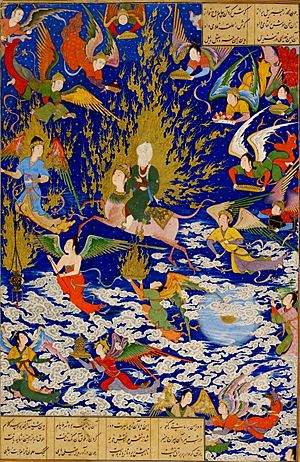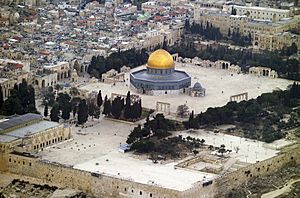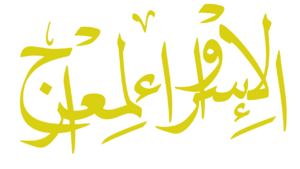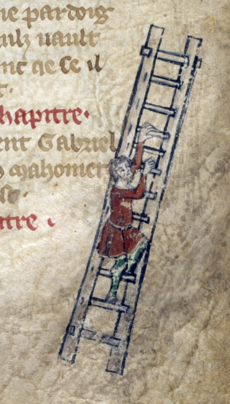Isra' and Mi'raj facts for kids


The Israʾ and Miʿraj (Arabic: الإسراء والمعراج, al-’Isrā’ wal-Miʿrāj) is a special Night Journey in Islam. It tells the story of the Islamic prophet Muhammad's (AD 570–632) journey during one night around the year AD 621. Muslims believe this journey was both physical and spiritual. A short version of the story is in the 17th chapter of the Quran, called al-Isra'. More details are found in the hadith, which are collections of Muhammad's teachings and sayings.
The journey has two main parts. In the Israʾ part, Muhammad traveled on a special creature called Buraq. He went from Mecca to Al-Aqsa (the Temple Mount) in Jerusalem. There, he led other prophets in prayer. In the second part, the Miʿraj, Muhammad ascended into heaven. He met different prophets and then spoke to God. God gave Muhammad important instructions about how Muslims should pray. This amazing journey is one of the most celebrated dates in the Islamic calendar.
Contents
Islamic Teachings About the Journey
The events of Isra and Miʿraj are briefly mentioned in the Quran. They are then explained more fully in the hadith. Hadith are like supplements to the Quran. They contain reported sayings and actions of Muhammad. Two important sources for these stories are Anas ibn Malik and Ibn ʿAbbas. Both were young boys when Muhammad made this journey.
The Quran's Message
Chapter 17 of the Quran, called al-Isra, is named after the Isra' journey. Its first verse describes the journey briefly. Other verses in the Quran also give clues about the Isra and Miʿraj.
Glory be to the One Who took His servant ˹Muḥammad˺ by night from the Sacred Mosque to the Farthest Mosque whose surroundings We have blessed, so that We may show him some of Our signs. Indeed, He alone is the All-Hearing, All-Seeing.
—Surah Al-Isra 17:1
And he certainly saw that ˹angel descend˺ a second time
at the Lote Tree of the most extreme limit ˹in the seventh heaven˺— near which is the Garden of ˹Eternal˺ Residence— while the Lote Tree was overwhelmed with ˹heavenly˺ splendours! The ˹Prophet's˺ sight never wandered, nor did it overreach. He certainly saw some of his Lord's greatest signs.—Surah An-Najm 53:13-18
Stories from the Hadith
Many hadith stories give much more detail about the Isra and Miʿraj. The Israʾ part is Muhammad's journey from Mecca to the "farthest place of worship." This journey began when Muhammad was in the Great Mosque in Mecca. The Archangel Jibrīl (also known as Gabriel) came to him. Gabriel brought Buraq, a special heavenly creature. Buraq carried Muhammad to the "farthest place of worship."
Muhammad got off Buraq, tied it, and prayed. Gabriel then tested him. It is said that Muhammad chose milk over wine and water. Gabriel told him this choice showed his "natural instinct" (Fitrah).
In the second part, the Miʿraj, Gabriel took Muhammad to the heavens. Miʿraj means "ladder" in Arabic. Muhammad visited the seven levels of heaven. He spoke with earlier prophets like Abraham (ʾIbrāhīm), Moses (Musa), John the Baptist (Yaḥyā ibn Zakarīyā), and Jesus (Isa).
Muhammad was then taken to Sidrat al-Muntaha. This is a holy tree in the seventh heaven. Gabriel was not allowed to go past it. According to Islamic tradition, God first told Muhammad that Muslims must pray fifty times a day. However, Moses told Muhammad that this would be too hard for people. Moses urged Muhammad to ask God for fewer prayers. Finally, the number of daily prayers was reduced to five.
Meeting the Prophets
There are different accounts of what happened during the Miʿraj. But most stories share the same main parts. Muhammad goes up into heaven with the angel Gabriel. He meets a different prophet at each of the seven levels of heaven. First, he meets Adam. Then John the Baptist and Jesus. After them, Joseph, then Idris, then Aaron, and then Moses. Lastly, he meets Abraham.
After meeting Abraham, Muhammad continues to meet God without Gabriel. God tells Muhammad that his people must pray 50 times a day. But as Muhammad comes back down, he meets Moses. Moses tells Muhammad to ask God for fewer prayers because 50 is too many. Muhammad goes back and forth between Moses and God nine times. Finally, the prayers are reduced to five daily prayers. God promises to reward these five prayers as if they were fifty. Moses still tells Muhammad to ask for even fewer. But Muhammad feels grateful and says he is thankful for the five.
Some stories also mention events before Muhammad went to heaven. Some scholars believe Muhammad's chest was opened. Water from Zamzam (a holy well) was poured on his heart. This was a cleansing ritual. It purified him and filled him with wisdom and faith for his journey.
European Stories
In the 1200s, a story of the Isra' and Mi'raj was translated into several European languages. These included Latin, Spanish, and French. This book was called the Book of Muhammad's Ladder. It claimed to be Muhammad's own words, written down by Ibn Abbas. This story might have influenced Dante Alighieri's famous book, the Divine Comedy. That book also describes a journey to heaven and hell.
How Muslims Celebrate Today
The Lailat al-Miʿraj (Arabic: لیلة المعراج, Lailatu 'l-Miʿrāj) is a special Muslim holiday. It is also known as Shab-e-Mi'raj in some countries. This holiday celebrates the Isra and Miʿraj. Some Muslims celebrate by offering extra prayers during this night. In some Muslim countries, cities are lit up with lights and candles.
People gather in mosques to pray and make special requests to God. Some share the story of Muhammad's journey. They talk about how his heart was purified by the archangel Gabriel. This prepared him to enter the seven levels of heaven. After prayers, food and treats are often served.
In Jerusalem, the Dome of the Rock is a famous building on the Temple Mount. It was built many years after Muhammad's death. It marks the spot from which Muhammad is believed to have gone up to heaven. The exact date of the journey is not fully clear. But it is celebrated as if it happened on the 27th of Rajab. This is a month in the Islamic calendar.
Similarities to Other Religions
Stories of people going to heaven while still alive are also found in old Jewish and Christian writings. In the Books of Kings from the Hebrew Bible/Old Testament, the prophet Elijah is said to have entered heaven alive "by fire." The Book of Enoch, an old Jewish book, describes an angel showing heaven to Enoch. He was the great-grandfather of Noah. Some believe early Muslims might have thought of this story when understanding Muhammad's night journey. In the Testament of Abraham, Abraham is shown how good and bad people are judged in heaven.
|
See also
 In Spanish: Isra y Mirach para niños
In Spanish: Isra y Mirach para niños



